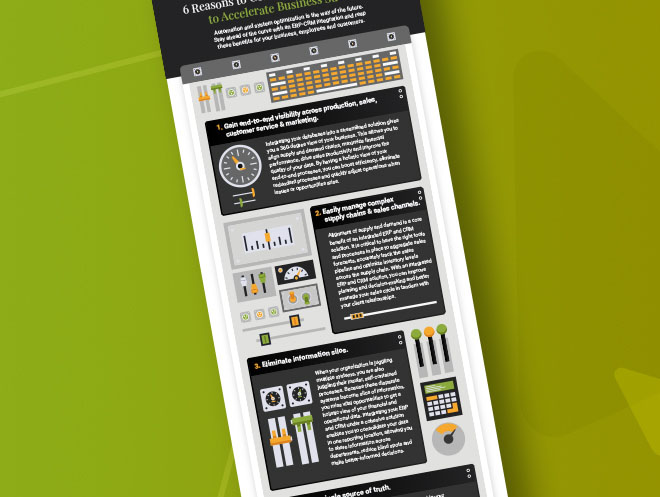
Updated June 07, 2023
Have you been thinking about what the right next steps should be for your current customer relationship management (CRM) system? If so, you may have wondered — do I just need a system update to achieve a handful of improvements, or are my current obstacles going to require me to implement an entirely new solution?
You have to factor in a number of considerations to design the best approach. If you don't have major problems with your current CRM, you may simply want to do an evaluation of your system to reveal ways you can refine processes for your team. Or it may be the case that a total replacement makes more sense than upgrading a CRM that's not meeting your company's needs, so a deeper strategy and transformation approach may fit the bill.
While it's tempting to launch an upgrade to address performance issues, it's important to first invest the time to review the existing CRM thoroughly to understand what's wrong, the best way to fix any issues, and the most effective project delivery methodology to ensure a smooth transition.
In some instances, data and performance issues can prevent you from upgrading your CRM effectively. For example, a life sciences client discovered during this plan-and-analyze phase that a lack of documentation and improper system design — along with integrity issues with historical data and a lack of CRM administration governance — would prevent them from adding the required extensions to their existing CRM.
In this situation, starting over with a fresh implementation allowed the company to clean their data internally before they uploaded it to a new CRM in its raw format. This ensured compatibility between their CRM and enterprise resource management (ERP) solutions and allowed the company to include the new functionality.
Deciding how to approach an implementation — whether it's an upgrade or replacement project — requires detailed discussions among business and technology leaders, end users and your implementation partners to address basic questions such as:
This stage will often uncover performance issues such as:
The project analysis phase also involves gathering requirements down to the user story level, which means defining what the key employees who use your CRM do every day. A user story includes three main pieces of information: the user's role, what they need to do, and the function they support.
These user stories will help you make key decisions while the implementation is being designed, determine development milestones and, ultimately, understand whether an implementation is successful.
It's also important to include change management and user training in your implementation plan. Helping users understand what's being implemented, the problems and processes you're working to correct, and the best way to use the CRM will all be important in mitigating risks and driving user adoption.
You should also pay attention to leading industry practices — such as automating data exchange between your CRM and ERP systems — as well as any regulatory considerations. For instance, a medical device company must track the components it purchases and the products it ships, as well as products that are returned or repaired. The right CRM can help with these tracking requirements.
Whether you are looking to gain insight into the health of your CRM system and what critical areas may need improvement, move from an on-premise solution to the cloud, or upgrade your cloud software, identifying the performance problems will clarify the direction you need to go.
Once you determine the goals for your implementation project, the next step in the planning process is deciding how you're going to approach the technology initiative.
This step is important because it includes taking a deeper look at the core challenges to your business — assessing where your organization is now, where you want to be and the obstacles that may be preventing you from achieving that next level. Once this is determined, you will have a better idea of how your CRM technology needs to be changed or integrated with other business systems to help you meet those goals.
In general terms, most technology implementations fall into one of two project management frameworks: waterfall or agile. It is possible to do a hybrid approach as well.
The waterfall framework calls for defining your requirements in the earliest phase of a project, building and testing features to meet those requirements, training users and deploying the software.
Waterfall offers a "big bang" approach that's best suited for situations where you understand your organization's requirements and don't expect significant issues or design changes as the software is implemented.
The agile framework, in contrast, is more of a "define as you go" approach in which different elements of a project are developed in short periods known as sprints. A need is defined, features are developed and deployed, and the overall project continues with a focus on a different feature or aspect.
The agile framework is best suited for situations where the company's requirements aren't understood as clearly, or it needs to correct specific aspects before continuing with an upgrade. With some projects, problems emerge during the implementation phase that require the company and its implementation partner to change priorities mid-stream. The agile framework offers the flexibility to shift the project's focus in response to newly discovered needs.
Some implementations are best served with a hybrid approach in which an overall design is developed under a waterfall methodology, but the implementation phase follows a series of agile sprints. This hybrid blends waterfall's big-picture project design with the flexibility and frequent communication more typically associated with agile implementations. Comparing these methods and choosing one (or the best features of both) provides an important framework that will, in turn, influence your project planning and the success of your CRM upgrade or replacement. Ultimately, your methodology will help your organization determine the technology gaps that need to be filled to successfully reach the desired future state for your business.
Upgrading or replacing your CRM may feel like a big task, and organizations are often unclear on how to determine the right next steps. A successful technology plan is possible by breaking it into logical steps — first identifying your current performance problems and then choosing the methodology that makes the most sense for executing the change. By undergoing this process, you will gain better ROI on your technology investments and your teams will be empowered to add more value to your organization.
Whether you know you need a new CRM or want to discover upgrade opportunities for your current system, contact our CRM implementation experts to ensure a successful tech strategy at your organization. Or learn more about how transforming your technology can accelerate growth and boost profitability in an increasingly digital world.


